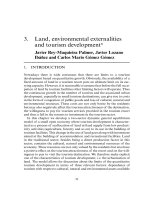THE ECONOMICS OF MONEY,BANKING, AND FINANCIAL MARKETS 471
Bạn đang xem bản rút gọn của tài liệu. Xem và tải ngay bản đầy đủ của tài liệu tại đây (45.37 KB, 1 trang )
CHAPTER 17
Tools of Monetary Policy
439
equals nonborrowed reserves (NBR), the amount of reserves that are supplied by
the Bank of Canada s open market operations. Nonborrowed reserves are set to
zero if the demand for reserves is also expected to be zero. Initially, the Bank of
Canada targeted a daily level of settlement balances of zero, but subsequently the
target level of settlement balances varied considerably depending on pressures on
the overnight rate; the Bank s target level of balances for a given day is always
announced the previous day. Assuming here that the Bank is targeting a level of
settlement balances of zero, the supply curve for reserves R s is thus the step function depicted in Figure 17-2.
Equilibrium in
the Market for
Reserves
Market equilibrium occurs where the quantity of reserves demanded equals the
quantity supplied. In terms of Figure 17-2, equilibrium occurs at the intersection
of the vertical supply curve and the demand curve at the Bank of Canada s target
level of reserves. More in-depth analysis shows that banks will set the demand for
reserves so that the demand curve is expected to intersect the supply curve at the
announced target overnight rate of i or* , with the result that deviations from the
announced target are fairly small.6
The equilibrium overnight interest rate is necessarily within the operating
band. For example, when the demand curve shifts to the left to R d1, the overnight
interest rate never falls below ib 0.50, while if the demand curve shifts to the right
to R d2 , the overnight interest rate never rises above ib. Thus the channel/corridor
system enables the Bank of Canada to keep the overnight interest rate in between
the narrow channel/corridor with an upper limit of ib and a lower limit of ib 0.50.
The important point of this analysis is that the channel/corridor approach
enables the Bank of Canada to set the overnight policy rate, whatever the demand
for reserves, including zero demand.
THE BAN K O F CAN ADA S APP ROACH TO M ON E TA RY PO L ICY
The goal of the Bank of Canada s current monetary policy is to keep the inflation
rate within a target range of 1% to 3%, with the midpoint of the inflation target range,
2%, being the most desirable outcome. In setting its inflation targets, the Bank of
Canada uses the rate of change in the consumer price index (CPI), because it is the
most commonly used and understood price measure in Canada. Although the Bank s
targets are specified in terms of headline CPI (all items), the Bank uses core CPI,
which excludes volatile components such as food, energy, and the effect of indirect
taxes. Core CPI inflation is useful in assessing whether trend inflation is on track for
the medium term. Also, defining the inflation targets in terms of ranges provides the
Bank of Canada sufficient flexibility to deal with supply shocks beyond those
already taken care of by the exclusion of volatile components from core inflation.
Figure 17-3 shows what has happened to the Canadian inflation rate since
February 26, 1991, after the Bank s governor and the minister of finance jointly
announced a series of declining inflation targets, with a band of plus and minus
one percentage point around them. In what follows, we examine the tools used
by the Bank of Canada to implement monetary policy, leaving a detailed analysis
of the Bank s monetary policy for Chapter 18.
6
See Michael Woodford, Monetary Policy in the Information Economy, in Symposium on Economic
Policy for the Information Economy (Federal Reserve Bank of Kansas City: 2001), pp. 297 370.









